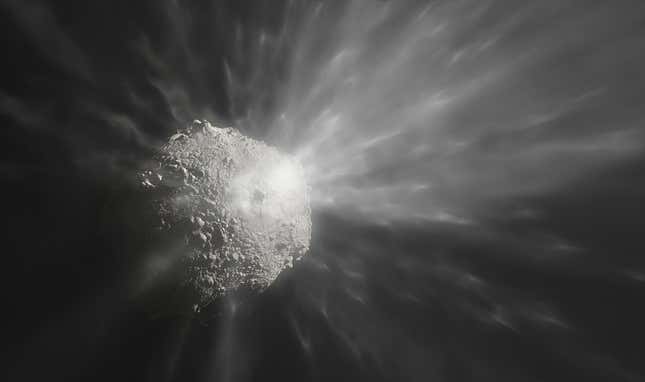
Last fall, NASA’s DART spacecraft smashed into Dimorphos, a small asteroid some 7 million miles away, in an unprecedented attempt to change the orbit of a natural body in space. Now, two teams of astronomers have released images of the collision’s aftermath taken by the European Southern Observatory’s Very Large Telescope.
The researchers found that the ejected cloud of debris from the asteroid appeared more blue than the space rock itself, indicating that Dimorphos is composed of fine particles. But as time passed after the crash, the debris formed a tail and clumps that may have been made up of larger particles. Both teams’ papers are published today in the journal Astronomy and Astrophysics.
“This research took advantage of a unique opportunity when NASA impacted an asteroid,” said Cyrielle Opitom, an astronomer at the University of Edinburgh and lead author of one of the studies, in an ESO release, “so it cannot be repeated by any future facility. This makes the data obtained with the VLT around the time of impact extremely precious when it comes to better understanding the nature of asteroids.”
DART (short for Double Asteroid Redirection Test) was designed to test whether humankind could change the trajectory of an asteroid. The importance of the test cannot be understated, as a space rock headed our way could cause mass death and destruction. DART proved that if such an asteroid appears, humanity has the means of changing its course.
Four 27-foot (8.2-meter) telescopes that make up the ESO’s Very Large Telescope captured the aftermath of the planetary defense mission. A bright light at the center of the images is Dimorphos, while the luminous rays spreading from it are debris from the collision.
The images were taken between September 26, 2022 (the date of the impact) and October 25, 2022. Streaks of light seen in the background are due to the apparent movement of background stars.

“When we observe the objects in our Solar System, we are looking at the sunlight that is scattered by their surface or by their atmosphere, which becomes partially polarized,” said Stefano Bagnulo, an astronomer at the Armagh Observatory and Planetarium in the UK and lead author of one of the studies, in an ESO release.
“Tracking how the polarization changes with the orientation of the asteroid relative to us and the Sun reveals the structure and composition of its surface,” Bagnulo added.
It took DART about 10 months to schlepp the nearly 7 million miles from Earth to Dimorphos, which is in a binary system with another asteroid, Didymos. Though it sounds quite far, 7 million miles is a great distance for telescopic observation.
Before today’s impact shots, the Italian-built LICIACube released nearby images of the initial impact, as did the Hubble and Webb Space Telescopes. The Southern Astrophysical Research (SOAR) Telescope in Chile, operated by NOIRLab, captured images of the impact’s 6,000-odd-mile debris trail. The Virtual Telescope Project, the Klein Karoo Observatory in South Africa, the South African Astronomical Observatory, and the ATLAS project also turned their gaze toward scene.
The images taken by so many different observatories will help scientists understand the success of the DART mission in great detail. Besides learning more about the composition of asteroids like Dimorphos, scientists will have a better idea of how to respond if an asteroid ever looks to be Earthbound.
More: The Most Intriguing Images of DART’s Fatal Encounter With an Asteroid